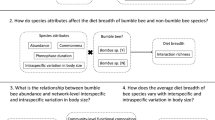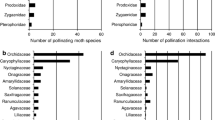Abstract
Mixed populations of the twospotted spider mite (TSM),Tetranychus urticae (Koch), and the Banks grass mite (BGM),Oligonychus pratensis (Banks), occur on corn and sorghum plants in late summer in the Great Plains. Interspecific matings between these arrhenotokous species occur readily in the laboratory but yield no female offspring. The effect of interspecific mating on female: male sex ratios was measured by examining the F1 progeny of females that mated with both heterospecific and conspecific males in no-choice situations. TSM females that mated first with BGM males and then with TSM males produced a smaller percentage of female offspring than TSM females that mated only with TSM males (43.1±5.8 and 78.9±2.8% females, respectively). Similarly, BGM females mated with heterospecific males and then with conspecific males produced fewer female offspring than females mated only with BGM males (55.7±5.2 and 77.5±2.5%, respectively). Lower female: male sex ratios were produced also by BGM females that mated with TSM males after first mating with conspecifics (62.4±3.4%). In mixed populations containing males of both species, females also produced lower female: male sex ratios, but these ratios were not as low as expected based on mating propensities and progeny sex ratios observed in no-choice tests. These data suggest that interspecific mating may substantially reduce female fitness in both mite species by reducing the output of female offspring, but in mixed populations this effect is mitigated by unidentified behavioral mechanisms.
Similar content being viewed by others
References
Austad, S. N. (1982). First male sperm priority in the bowl and doily spider,Frontinella pyramitela (Walckenaer).Evolution 36 777–785.
Boudreaux, H. B. (1963). Biological aspects of some phytophagous mites.Annu. Rev. Entomol. 8 137–154.
Collins, R. D., and Margolies, D. C. (1991). Possible ecological consequences of heterospecific mating behavior in tetranychid mites.Exp. Appl. Acar. 13 97–105.
Collins, R. D., Margolies, D. C., and Rose, S. (1993). Guarding behavior and reproductive isolation in two tetranychid mite species (Acari: Tetranycidae).Ann. Entomol. Soc. Am. 86 111–116.
Dickinson, J. L. (1986). Prolonged mating in the milkweed leaf beetleLabidomera clivicollis clivicollis (Coleoptera: Chrysomelidae): A test of the “sperm-loading” hypothesis.Behav. Ecol. Sociobiol. 18 331–338.
Fincke, O. M. (1984). Sperm competition in the damselflyEnallagma hageni Walsh (Odonata: Coenagrionidae): Benefits of multiple mating to males and females.Behav. Ecol. Sociboiol. 14 235–240.
Helle, W. (1967). Fertilization in the twospotted spider mite (Tetranychus urticae: Acari).Entomol. Exp. Appl. 10 103–110.
King, B. H. (1987). Offspring sex ratios in parasitoid wasps.Q. Rev. Biol. 62 367–396.
Krainacker, D. A., and Carey, J. R. (1989). Reproductive limits and heterogeneity of male two-spotted spider mites.Entomol. Exp. Appl. 50 209–214.
Laing, J. E. (1969). Life history and life table ofTetranychus urticae Koch.Acarologia 9 32–42.
Martyniuk, J., and Jaenike, J. (1982). Multiple mating and sperm usage patterns in natural populations ofProlinyphia marginata (Araneae: Linyphiidae).Ann. Entomol. Soc. Am. 75 516–518.
McVey, M. E., and Smittle, B. J. (1984). Sperm precedence in the dragonflyErythemis simplicicollis.J. Insect Physiol. 30 619–628.
Mitchell, R. (1970). An analysis of dispersal in mites.Am. Nat. 104 425–431.
Norusis, M. J. (1990).SPSS/PC+Statistics 4.0, SPSS Inc., Chicago.
Overmeer, W. P. J. (1972). Notes on mating behavior and sex ratio control ofTetranychus urticae Koch (Acarina: Tetranychidae).Entomol. Ber. 32 240–244.
Parker, G. A. (1970). Sperm competition and its evolutionary effect on copula duration in the flyScatophaga stercoraria.J. Insect Physiol. 16 1301–1328.
Pickett, C. H., and Gilstrap, F. E. (1985). Dynamics of spider mite species (Acarina: Tetranychidae) composition infesting corn.J. Kans. Entomol. Soc. 58 503–508.
Potter, D. A., and Wrensch, D. L. (1978). Interrupted matings and the effectiveness of second inseminations in the twospotted spider mite.Ann. Entomol. Soc. Am. 71 499–501.
Rubenstein, D. I. (1989). Sperm competition in the water strider,Gerris remigis.Anim. Behav. 38 631–636.
Sherman, P. W., and Westneat, D. F. (1988). Multiple mating and quantitative genetics.Anim. Behav. 36 1545–1547.
Singer, F. (1990). Reproductive costs arising from incomplete habitat segregation among three species of Leucorrhinia dragonflies.Behavior 115 188–202.
Sokal, R. R., and Rohlf, F. J. (1981).Biometry, 2nd ed., W. H. Freeman, New York.
Thornhill, R., and Alcock, J. (1983).The Evolution of Insect Mating Systems, Harvard University Press, Cambridge, MA.
Waage, J. K. (1984). Sperm competition and the evolution of odonate mating systems. In Smith, R. L. (ed.),Sperm Competition and the Evolution of Animal Mating Systems, Academic Press, New York, pp. 252–290.
Watson, P. J. (1991). Multiple paternity and first mate sperm precedence in the Sierra dome spider,Linyphia litigiosa Keyserling (Linyphiidae).Anim. Behav. 41 135–148.
Wrensch, D. L. (1992). Variability in sex ratio: Intrinsic vs extrinsic factors. In Wrensch, D. L., and Ebbert, M. (eds.),Evolution and Diversity of Sex Ratio in Insects and Mites, Chapman & Hall, New York.
Wrensch, D. L., and Young, S. S. Y. (1975). Effects of quality of resource and fertilization status on some fitness traits in the two-spotted spider mite,Tetranychus urticae Koch.Oecologia 18 259–267.
Wyatt, I. J., and White, P. F. (1977). Simple estimation of intrinsic increase rates for aphids and tetranychid mites.J. Appl. Ecol. 14 757–766.
Zar, J. H. (1984).Biostatistical Analysis, 2nd ed., Prentice-Hall, Englewood Cliffs, NJ.
Author information
Authors and Affiliations
Rights and permissions
About this article
Cite this article
Collins, R.D., Margolies, D.C. The effect of interspecific mating on sex ratios in the twospotted spider mite and the Banks grass mite (Acarina: Tetranychidae). J Insect Behav 8, 189–206 (1994). https://doi.org/10.1007/BF01988904
Accepted:
Issue Date:
DOI: https://doi.org/10.1007/BF01988904




